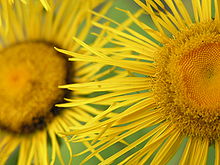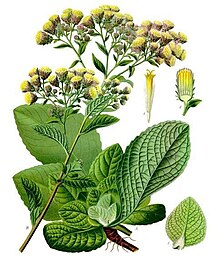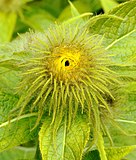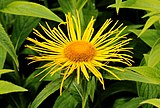Inula
| Inula | |
|---|---|

| |
| Inula helenium[1] | |
| Scientific classification | |
| Kingdom: | |
| (unranked): | |
| (unranked): | |
| (unranked): | |
| Order: | |
| Family: | |
| Subfamily: | |
| Tribe: | |
| Genus: | Inula |
| Synonyms[2] | |
| |



Inula is a large genus of about 90 species of flowering plants in the family Asteraceae, native to Europe, Asia and Africa.
They may be annuals, herbaceous perennials or subshrubs that vary greatly in size, from small species a few centimeters tall to enormous perennials over 3 m (10 ft) tall. They carry yellow daisy-like composite flowerheads often with narrow ray-florets.
Some common characteristics include pappus with bristles, flat capitulum, and lack of chaff.
Several species are popular flowers for the garden, with cultivation going back to antiquity. The smaller species are used in rock gardens and the more common larger ones, which tend to have very coarse foliage, in borders.
Etymology
The genus name inula, of uncertain origin, was already used by the Romans. The Latin phrase inula campana (field inula) gave rise to the English elecampane whose scientific name is Inula helenium. The plant's specific name, helenium, derives from Helen of Troy; elecampane is said to have sprung up from where her tears fell.[3]
Selected species
- Inula acaulis Schott & Kotschy ex Tchihat. – stemless inula
- Inula acervata S.Moore
- Inula acinacifolia Gand.
- Inula acuminata DC.
- Inula afghanica
- Inula anatolica Boiss.
- Inula auriculata Boiss. & Balansa
- Inula bifrons (L.) L.
- Inula britannica L. – British yellowhead
- Inula candida (L.) Cass.
- Inula cappa (Buch.-Ham. ex D. Don) DC.
- Inula caspica Blume
- Inula clarkei ( Hook.f.) R.R.Stewart
- Inula conyzae (Griess.) Meikle – ploughman's-spikenard
- Inula crithmoides L. – golden samphire (syn. Limbarda crithmoides (L.) Dum.)
- Inula cuspidata
- Inula ensifolia L.
- Inula eupatorioides DC.
- Inula falconeri Hook.f.
- Inula forrestii
- Inula germanica L.
- Inula grandis Schrenk ex Fisch. & C. A. Mey.
- Inula helenioides DC.
- Inula helenium L. – elecampane
- Inula helianthus-aquatica
- Inula helvetica Weber
- Inula hirta L.
- Inula hookeri C. B. Clarke
- Inula hupehensis
- Inula japonica
- Inula koelzii R.Dawar & Qaiser
- Inula lineariifolia Turcz.
- Inula magnifica
- Inula montana L.
- Inula multicaulis Boiss.
- Inula nervosa
- Inula obtusifolia A.Kern.
- Inula oculus-christi L.
- Inula orientalis Lam.
- Inula pterocaula
- Inula racemosa Hook.f.
- Inula rhizocephala Schrenk ex Fisch. & C. A. Mey.
- Inula rhizocephaloides
- Inula rubricaulis
- Inula salicina L. – Irish fleabane, willowleaf yellowhead
- Inula salsoloides
- Inula sericophylla
- Inula spiraeifolia L.
- Inula stewartii Abid & Qaiser
- Inula subfloccosa Rech.f.
- Inula thapsoides Spreng.
- Inula verbascifolia (Willd.) Hausskn.
- Inula wissmanniana
Select species formerly in Inula
- Inula dysenterica L. => Pulicaria dysenterica (L.) Bernh.
- Inula graminifolia Michx. => Pityopsis graminifolia (Michx.) Nutt.
- Inula graveolens (L.) Desf. => Dittrichia graveolens (L.) Greuter – stinkwort, stinkweed
- Inula indica L. => Pentanema indicum (L.) Y.Ling
- Inula mariana L. => Chrysopsis mariana (L.) Elliott
- Inula primulifolia Lam. => Conyza primulifolia (Lam.) Cuatrec. & Lourteig
- Inula subaxillaris Lam. => Heterotheca subaxillaris (Lam.) Britton & Rusby
- Inula viscosa => Dittrichia viscosa – false yellowhead, sticky fleabane, woody fleabane
Ecology
Inula species are used as food plants by the larvae of some Lepidoptera species including case-bearers of the genus Coleophora, such as C. conyzae (recorded on I. conyzae), C. follicularis, C. inulae, and C. troglodytella.
Gallery
-
Inula hookeri. Budding flower bud.
-
Inula hookeri. Inflorescence.
References
- ^ 1897 illustration from Franz Eugen Köhler, Köhler's Medizinal-Pflanzen
- ^ a b "Flann, C (ed) 2009+ Global Compositae Checklist". Archived from the original on 2014-12-09. Retrieved 2014-12-09.
- ^ Melderis, A. (2007). A Handbook of British Flowering Plants. READ BOOKS. p. 271. ISBN 1-4067-6632-1. Retrieved 2009-04-13.
External links
- Flora Europaea: Inula
- Flora of China: list of Chinese Inula species
- Anderberg, A. (1991). "Taxonomy and phylogeny of tribe Inuleae (Asteraceae)". Pl. Syst. Evol. 176 (1–2): 75–123. doi:10.1007/BF00937947.
- Rubina Abid and M. Qaiser (2003). "Chemotoxonomic study of Inula L. (s.str.) and its allied genera (Inuleae - Compositae) from Pakistan and Kashmir". Pak. J. Bot. 35 (2): 127–140.


